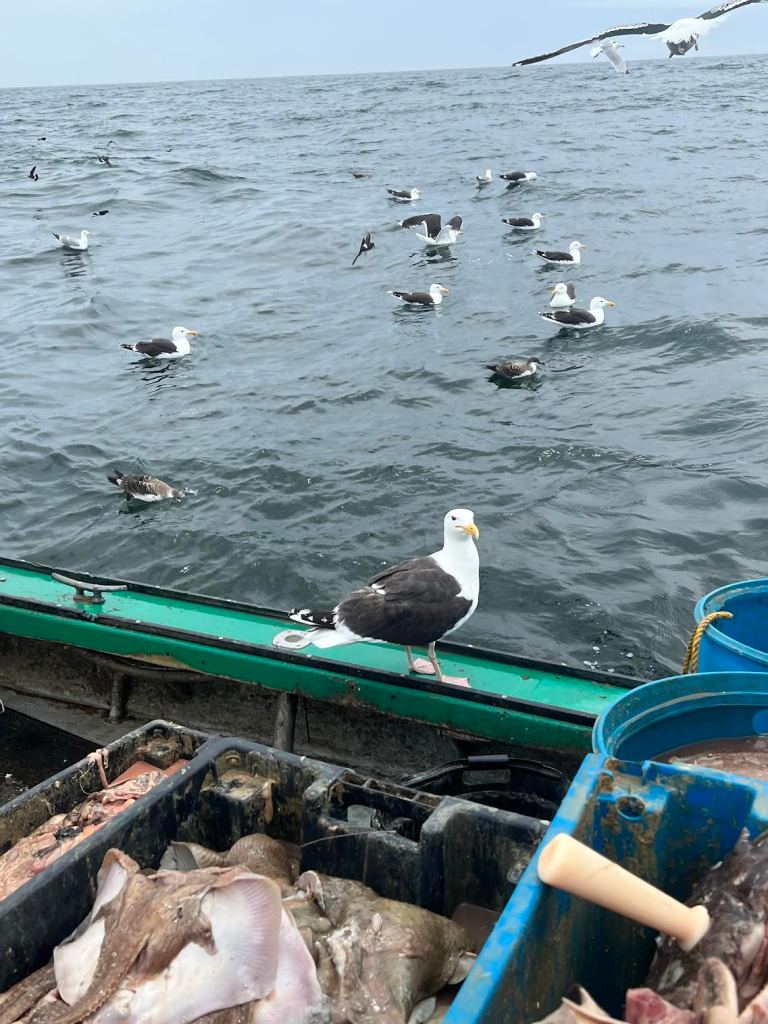Our ragtag, oddball, Gulls of Appledore Research Group takes something of an unconventional approach to studying our bird friends. We are not paid to do this work, and it’s not tied to any academic lab with a mandate to churn out papers on the subject. While this leads to a certain precarity (of funding, in particular), it also yields us freedom to wonder. We take more of a natural historian’s perspective, as a result, and make no attempts to draw statistics-based conclusions about aggregates or populations. Our time among the gulls has shown us that they are individuals in just such a way as we humans are. Most of our team is trained in a blend of sciences and humanities, and we bring to the project a storyteller’s eye for plot lines, emotional registers, aesthetics.
Lately, I’ve been thinking about how often the little window we get into a gull’s life functions like a writing prompt. You get a stem of a story, a glimpse of something, a moment, and then you need to run with it, constructing an imaginative realm from the thinnest strand of a beginning.
When Friend of Gulls John Makowsky wrote to me earlier this summer asking “Where are all the adult Black-Backeds?” I found myself mulling the question and spinning out all manner of possible tales. The fact is, some, or most, of these questions are not answerable, but I sure do love to wonder about it.
John sent some photos of the one day in June when several Great Black-Backed Gulls turned up near his lobster boat. But that sight was, in most years, a regular occurrence, not a once-a-summer thing.

John was seeing his good friend Red Eye, and her mate, Hero, all summer, as well as some younger Black-Backeds. But he was accustomed to larger groups of the adults turning up together, and it just wasn’t happening this summer. So, where were they?
I have no satisfying answers to that. I know that some of the gulls that visit John’s boat out in the Gulf of Maine are Appledore breeders, but many probably are not, and come from other islands, or even are taking the whole year off from breeding and are just bumming around all summer. So it’s hard to say what might be going on here. It could be that there are just fewer gulls around–we know their populations continue to decline, and just on Appledore, we did lose a couple dozen adults to avian flu last year. The broader losses across the Northeast must have been much greater. It also could be that the gulls were shifting their activities elsewhere, and had found some other food sources. It could be both things at once: declining gull populations mean more options for the remaining gulls in terms of places to go to eat. Who knows?
Red Eye reliably came all summer though, and brought her mate along. Now that fall is here, her mate has gone off someplace else. This is common in gulls: they work in intense partnership all summer to raise their young, but then, once the babies are fledged (or die), the two often go their separate ways for the winter. Often they will meet up again in spring and stick with the same mate for many years in this pattern. Often, they will have found someone new when April rolls around. I was reading a paper about another species of gull, the Black-legged Kittiwake, where researchers found that these divorces are more common in pairs that fail to raise any babies to fledging. (My favorite line from the write-up of this study: “Each bird was subjected to a personality test to determine their level of bravery, which included observing their reaction to a blue plastic penguin toy.”) Some of our work with the gulls on Appledore (Dr. Kristen Covino’s, especially) has been looking at these very things–individual personalities, compatibility, success in raising youngsters. The same sorts of things we wonder about in human couplings, of course.

I wonder where Hero is now. I wonder where all the gulls of Appledore are now that the island is emptied out of them. We get sightings of so many of our banded birds from you all, but many of our banded birds are never seen off island, or outside of summer. I wonder about them. I wonder about the persistent gaps in our knowledge even in birds that are seen and reported, but only intermittently, or only in certain seasons. I love the gulls that turn up predictably, all year, in the same spot, like Red Eye, and I love the ones that disappear and keep their secrets.
Nice reflections on the mysteries of our feathered friends. It makes me wonder though – how many of the gulls you work with are you able to fix up with a MOTUS tag?
We don’t use MOTUS tags specifically since our birds are so large, they can carry a more substantial GPS loggers, and also because they generally come back to Appledore so we can recapture them and take the logger off. We’ve placed about 6 of those in the past (due to expense). To give a sense of proportion, we’ve banded a few thousand birds, but only placed loggers on this handful. We have a grant to deploy another ten I think in coming years, so more insights into some of their mysteries to come!